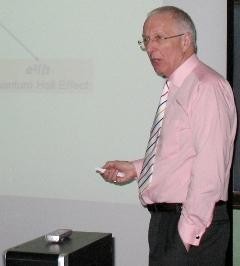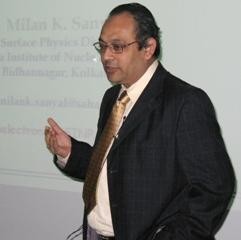
Michael Pepper at the nanoelectronics workshop.
There is plenty of room at the bottom, said Richard Feynman nearly fifty years ago predicting the astonishing field of nanoscience. From the realm of conjecture and extrapolation to the fringes of reality, nanoscience has come a long way. Though fledgeling now, it is poised to revolutionize every domain of science and technology. One such realm is electronics.
At a meet on November 27 discussing challenges in nanoelectronis at Kolkata's Saha Institute of Nuclear Physics, noted British physicist Michael Pepper, known for his work in semiconductor nanostructures, delved deep into high frequency electron transport and quantum cryptography.
Of his team's work on gallium-arsenide semiconductors at Cambridge University, Pepper said, "We have been able to trap and push electrons along the surface of the semiconductors using acoustic waves." This will have potential applications in quantum computing, he said. The ability to tinker with photon has spawned the exciting field of quantum cryptography. On the prospect of quantum cryptography, Pepper said, "Data can be encrypted and sent through public distribution system using a single photon. It is secure as photon cannot be split and copied faithfully."
Talking to Nature India on the sidelines of the workshop jointly organised by SINP and Institute of Radiophysics and Electronics of Calcutta University, Pepper said his group collaborates with semiconductor researchers at the Indian Institute of Science, Bangalore under the UK-India Education and Research Initiative (UKIERI). The research veers around growth and optimisation of semiconductors and device fabrication with high-resolution semiconductor lithography, he said.

Milan Sanyal at the meet.
Among the nanomaterials, conducting polymer nanowire has wonderful properties. SINP's Milan Kumar Sanyal said, the interesting feature of such nanopolymers is the presence of Wigner crystals made of electrons, which on being exposed to a certain threshold voltage, move in a stick-and-slip motion like an iron chain being dragged along the floor.
Besides nanopolymers, thiol-capped gold nanoparticles measuring three nm (nanometer) have been developed. These gold nanoparticles show magnetic as well as electrical properties, Sanyal said. Such nanomaterials will enhance computer memory. "We foresee a collaborative research with Pepper's team," Sanyal told to Nature India. "We could share insights in fundamental physical laws as both Pepper's and our teams have witnessed Wigner crystals in the respective nanomaterials we work with," he said.
Unveiling the secrets of graphene, Sangam Banerjee of SINP said it was a potential candidate for FET (field-effect transistor) applications.
